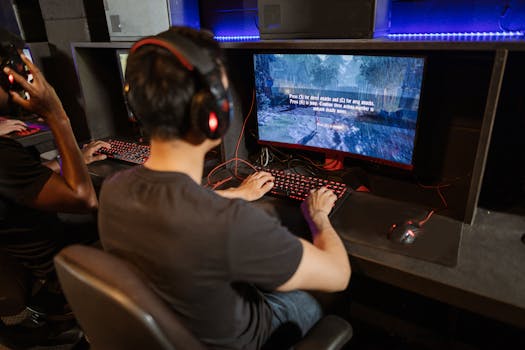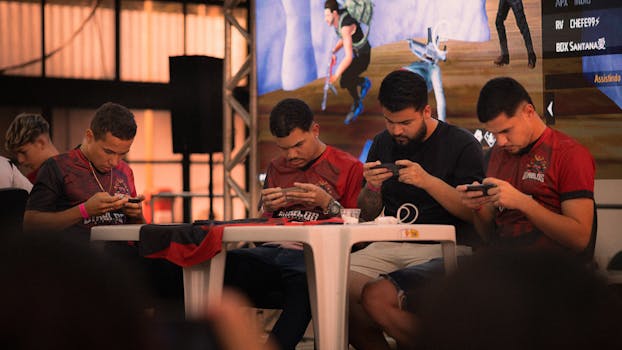eSports
How eSports Games are Influencing Traditional Sports: The eSports Influence Explained
Explore how esports influence from mobile gaming is reshaping traditional sports, transforming coaching methods, fan engagement, athlete branding, and live broadcast tactics. Learn what to adopt today.
Advertisement
How eSports Games are Influencing Traditional Sports: The eSports Influence Explained
Watching gamers battle on mobile screens seems worlds apart from stadium chants. Yet, as interest in digital competition grows, the esports influence quietly transforms how people experience all kinds of sports today.
From live event production to athlete branding, traditional sports increasingly borrow techniques and energy from the booming realm of esports. Audiences expect excitement, instant updates, and accessible platforms—demands strongly shaped by mobile gaming culture and innovation.
This article explores exactly where esports influence turns tradition on its head. You’ll discover how teams, leagues, and athletes are actively adapting gaming concepts, creating a new playbook for sports fans everywhere.
Esports Broadcast Styles Shape Mainstream Sports Production
Viewers see clear shifts in sports coverage, thanks to esports influence. Broadcasters rapidly update camera angles, integrate live statistics, and create real-time conversations reminiscent of a live game stream.
Major leagues add features first tested in popular games, such as onscreen graphics, instant statistical overlays, and rapid highlight reels. Audiences stay engaged, picking up energy from traditional sports and gaming broadcasts alike.
Overlay Technology Unlocks New Fan Experiences
On-screen data, once rare, now appears constantly: scores, leaderboards, and even player heart rates. Esports influence guides these overlays, making every moment feel active and immersive during mobile or televised replays.
This technique keeps fans informed, mimicking popular gaming interfaces. Imagine watching NBA replays with player stats popping up mid-play, letting you compare today’s action to records without leaving your seat.
Sports coverage teams follow game designers by updating graphics after each whistle, enhancing every broadcast and helping newcomers follow the game at a glance. Try learning player stats during your next TV game—it’s seamless now.
Chat Features Bring Real-Time Community to the Forefront
Live commentary sections, a staple of esports streams, make viewers feel involved. Sports broadcasts now enable fan chats, reactions, and shareable snippets—directly within apps or even on-screen during high-intensity matches.
This esports influence fosters instant community. Clubs replicate “watch party” sessions, letting you join fellow fans around the world, much like popular gaming tournaments do every weekend via mobile platforms.
At a recent pro football game, app users voted for play-of-the-game live, echoing esports polling tools. If you want to join the conversation, these features make it easy—just follow in-app prompts.
| Broadcast Element | Pre-Esports Coverage | With Esports Influence | Lesson for Traditional Sports |
|---|---|---|---|
| Camera Angles | Limited, fixed positions | Dynamic, player POVs | Offer multiple perspectives for deeper fan engagement |
| Live Data Overlays | Main scoreboard only | Real-time stats and analytics | Integrate rich, interactive data for context |
| Fan Chat/Interaction | 1-way streaming, no feedback | Live chat, polls, reactions | Promote two-way engagement for a sense of community |
| Replay Features | Scheduled highlights | Instant replays, multi-angle | Provide on-demand, user-controlled replays |
| Personalized Content | Same feed for all viewers | Customized stats & views | Personalize streams based on preferences |
Team Management Copies Key Esports Principles for Player Development
Coaches and managers use frameworks from esports influence to support teamwork, performance reviews, and skill growth. High-level sports teams analyze play data with software, echoing the post-game scrims of gaming pros.
Instead of relying solely on traditional drills, coaches encourage athlete self-review by sharing detailed video breakdowns, inspired by popular esports coaching techniques that optimize small improvements each week.
Scouting and Recruitment Transformed by Analytics
Scouts think like esports analysts, focusing on individual skill and in-game decision-making instead of just physical stats. Mobile gaming metrics guide them, such as reaction speed and map awareness.
Top sports teams now set up data-driven tryouts using apps that record every move. As a result, recruits get fair feedback on tactical strengths and communication, much like aspiring gamers do in competitive leagues.
- Record all scrimmages and analyze replays. Helps spot small errors and fast improvements, inspired by elite gaming squads.
- Encourage peer coaching sessions. Builds trust and creative tactics for both gamers and athletes used to solo practice.
- Adopt task-based review cycles. Breaks big goals down to daily habits, following common mobile gaming quest systems for sustained results.
- Integrate digital wellness checks. Use gaming-based rest alerts to track burnout and ensure balanced routines.
- Feature leaderboards in practice. Fosters friendly competition, keeping athletes motivated and mirroring popular multiplayer environments.
Start by reviewing one recent game using an app with analytics, even if you only track a single stat or action type for skill development this week.
Communication Norms Migrate from Gaming to Locker Rooms
Esports teams succeed by running “debriefs”—short, focused meetings after every round. Traditional coaches now mirror this, creating 5-minute “what worked” sessions that replace one-sided lectures.
Mobile apps facilitate group chats regardless of player location, allowing constant real-time feedback. These supportive exchanges resemble gamer circles, where everyone quickly shares wins, flops, or needs for next match-ups.
- Host postgame debriefs in a circle. Builds a non-judgmental feedback culture, helping teams improve daily just like competitive game crews do.
- Assign a “callout leader” each week. Rotating leadership avoids blaming behavior and ensures every person gets experience, similar to in-game captains.
- Set up short video check-ins. Video chat lets injured or remote teammates participate, supporting ongoing engagement like in global mobile tournaments.
- Adopt shared goal trackers. Digital boards clarify targets and reward progress, an adaptation from goal systems in many esports titles.
- Celebrate micro-goals together. Building positive morale after minor wins builds long-term resilience—a lesson straight from the gaming world.
Try implementing a 5-minute group check-in after your next practice session—you’ll spot the energy shift from day one when everyone is heard and valued.
Fan Engagement Evolves with Interactive Digital Tools
Traditional sports teams now use esports influence to deepen connections, turning fans into active contributors instead of passive viewers. Interactive polls, social integrations, and personalized digital rewards create a lively game-day experience.
Incentive Systems Reward Participation, Not Just Attendance
Loyalty apps give points for every activity—posting photos, voting on plays, cheering in-app, or completing trivia. These mechanics work because mobile gaming design popularized tiered achievements and unlockable digital rewards.
A local basketball club offered badges and discounts for fans who completed weekly prediction challenges. Fans quickly embraced the format, echoing the fun of earning trophies while gaming on the go.
If you’re part of a club or team, host a weekly micro-challenge for fans to earn recognition, whether virtual badges or a featured spot on your website.
Custom Content Streams Put Fans in Control
Instead of waiting for scheduled replays, sports teams deliver “choose your highlight” features, letting fans control which plays they review. Streaming tools, first popular in mobile esports, lead this change.
At major games, users can now toggle between different player cameras and view stats that update based on personal preferences. This creates a customized experience familiar to anyone who follows esports influence trends online.
Try navigating a pro sports app during a live event. Chances are you’ll find player highlights and fan polls right beneath the main action, ready to try out immediately.
Athlete Branding Borrows Strategies from eSports Stars
Stars in both sports and gaming know personal engagement builds loyal followings. Mobile gaming cultures teach traditional athletes to share training routines, behind-the-scenes updates, and quick polls directly with their audiences.
Micro-Interaction Drives Stronger Fandom
Game streamers thrive on short, genuine messages—”Thanks for the support!” or “Shoutout to Sam in Texas!”—and now, sports stars use similar language in TikToks, tweets, or fan forums to grow more relatable followings.
Mobile athletes use post-game Q&As, shoutouts, and emoji polls to keep conversations going even off the field. This habit, influenced by the eSports influence, strengthens bonds and gives fans daily touchpoints across platforms.
If you manage athlete accounts, reply to three fans daily using their names and referencing recent plays. The resulting engagement boost is easy to measure after a month or two.
Collaborations and Partnerships Gain Gaming Flair
Joint livestreams, once unique to game launches, now bring together football or basketball stars with top streamers or big-name mobile gamers. Athletes learn new fan interaction tricks and swap stories, reaching wider audiences in the process.
Recent “duo” sessions between NBA and gaming personalities sent social streams buzzing. Gamers and athletes trade favorite drills and app picks, inviting both communities to participate and cross-promote their respective events.
If you’re looking to grow an athlete’s digital brand, arrange a playful Q&A with a mobile gamer or local streamer. Fans enjoy crossover stories and discover common ground between two worlds.
New Traditions: Sports and Gaming Merge in Lasting Ways
Esports influence has fundamentally reshaped everything from coaching to fan experience. With fresh approaches drawn from mobile gaming, teams and athletes adapt at lightning speed, changing what it means to tune in or join up.
Whether watching pros on a mobile screen or cheering local teams, fans now expect active participation, personalized content, and instant access—a direct result of esports blending with sports traditions globally.
As new technology and culture bridge these worlds, both sports and gaming unlock limitless potential. The future welcomes creative fans and flexible athletes, ready to lead wherever esports influence takes them next.





